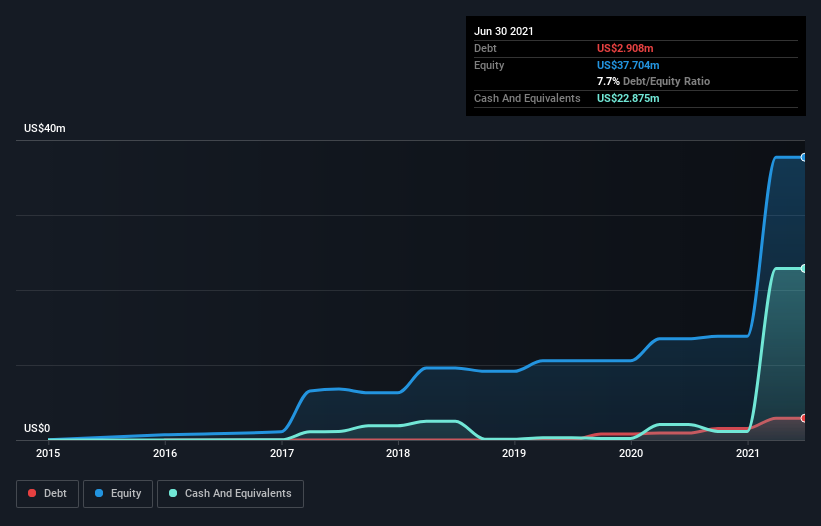Is Phoenix Copper (LON:PXC) A Risky Investment?
The external fund manager backed by Berkshire Hathaway's Charlie Munger, Li Lu, makes no bones about it when he says 'The biggest investment risk is not the volatility of prices, but whether you will suffer a permanent loss of capital.' When we think about how risky a company is, we always like to look at its use of debt, since debt overload can lead to ruin. We can see that Phoenix Copper Limited (LON:PXC) does use debt in its business. But is this debt a concern to shareholders?
When Is Debt A Problem?
Debt is a tool to help businesses grow, but if a business is incapable of paying off its lenders, then it exists at their mercy. In the worst case scenario, a company can go bankrupt if it cannot pay its creditors. However, a more common (but still painful) scenario is that it has to raise new equity capital at a low price, thus permanently diluting shareholders. Of course, plenty of companies use debt to fund growth, without any negative consequences. The first thing to do when considering how much debt a business uses is to look at its cash and debt together.
Check out our latest analysis for Phoenix Copper
How Much Debt Does Phoenix Copper Carry?
You can click the graphic below for the historical numbers, but it shows that as of June 2021 Phoenix Copper had US$2.91m of debt, an increase on US$929.0k, over one year. But it also has US$22.9m in cash to offset that, meaning it has US$20.0m net cash.
A Look At Phoenix Copper's Liabilities
We can see from the most recent balance sheet that Phoenix Copper had liabilities of US$3.53m falling due within a year, and liabilities of US$757.7k due beyond that. Offsetting this, it had US$22.9m in cash and US$88.8k in receivables that were due within 12 months. So it actually has US$18.7m more liquid assets than total liabilities.
This excess liquidity suggests that Phoenix Copper is taking a careful approach to debt. Given it has easily adequate short term liquidity, we don't think it will have any issues with its lenders. Simply put, the fact that Phoenix Copper has more cash than debt is arguably a good indication that it can manage its debt safely. There's no doubt that we learn most about debt from the balance sheet. But ultimately the future profitability of the business will decide if Phoenix Copper can strengthen its balance sheet over time. So if you're focused on the future you can check out this free report showing analyst profit forecasts.
Since Phoenix Copper has no significant operating revenue, shareholders probably hope it will develop a valuable new mine before too long.
So How Risky Is Phoenix Copper?
Statistically speaking companies that lose money are riskier than those that make money. And in the last year Phoenix Copper had an earnings before interest and tax (EBIT) loss, truth be told. And over the same period it saw negative free cash outflow of US$5.1m and booked a US$581k accounting loss. Given it only has net cash of US$20.0m, the company may need to raise more capital if it doesn't reach break-even soon. Overall, its balance sheet doesn't seem overly risky, at the moment, but we're always cautious until we see the positive free cash flow. There's no doubt that we learn most about debt from the balance sheet. However, not all investment risk resides within the balance sheet - far from it. These risks can be hard to spot. Every company has them, and we've spotted 4 warning signs for Phoenix Copper (of which 3 are concerning!) you should know about.
At the end of the day, it's often better to focus on companies that are free from net debt. You can access our special list of such companies (all with a track record of profit growth). It's free.
This article by Simply Wall St is general in nature. We provide commentary based on historical data and analyst forecasts only using an unbiased methodology and our articles are not intended to be financial advice. It does not constitute a recommendation to buy or sell any stock, and does not take account of your objectives, or your financial situation. We aim to bring you long-term focused analysis driven by fundamental data. Note that our analysis may not factor in the latest price-sensitive company announcements or qualitative material. Simply Wall St has no position in any stocks mentioned.
Have feedback on this article? Concerned about the content? Get in touch with us directly. Alternatively, email editorial-team (at) simplywallst.com.

 Yahoo Finance
Yahoo Finance 
